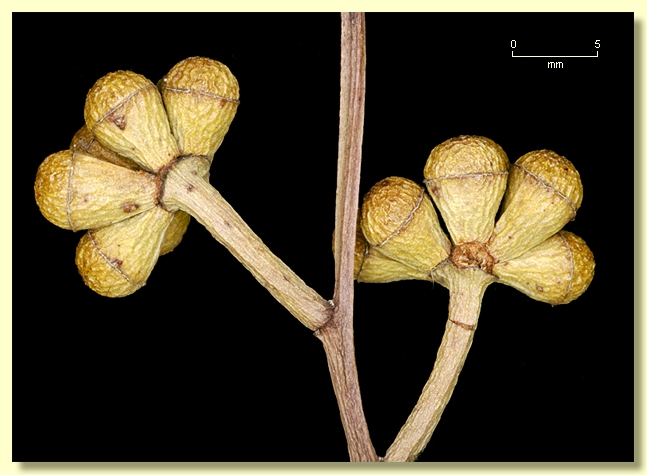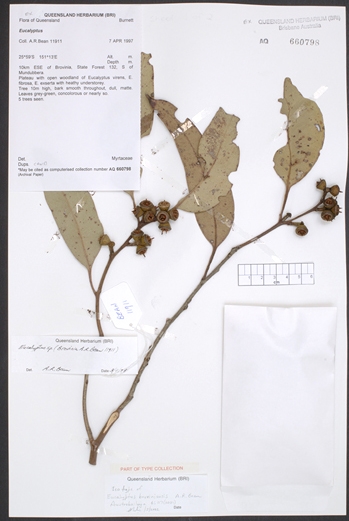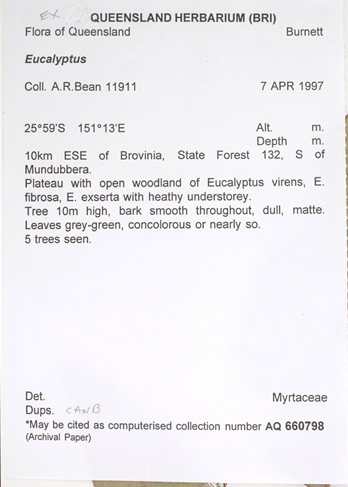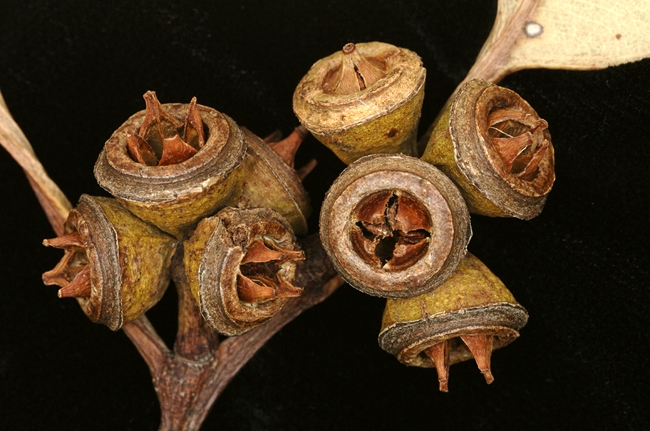Eucalyptus | Symphyomyrtus | Exsertaria | Connexentes
Euclid - Online edition
Eucalyptus broviniensis
Eucalyptus broviniensis A.R.Bean, Austrobaileya 6 (1) 117 (2001).
T: Queensland: Burnett District: 10 km ESE of Brovinia State Forest 132, S of Mundubbera, 7 April 1997, A.R.Bean 11911; holo: BRI; iso: CANB.
Small tree to c. 10 m tall. Forming a lignotuber.
Bark smooth, new bark pale orange, maturing to mottled grey, becoming granular with age,.
Juvenile growth (coppice or field seedlings to 50 cm): stems round in cross-section, not glaucous; juvenile leaves always petiolate, alternate, ovate, 6–12 cm long, 4–7 cm wide, base tapering to rounded, light green.
Adult leaves alternate, petioles 2–4 cm long; blade lanceolate, 10–15 cm long, 2.5–4.5 cm wide, base tapering to petiole, margin entire, apex pointed, concolorous, dull green, side-veins acute or at a wider angle than 45° to the midrib, reticulation dense, intramarginal vein present, oil glands mostly island or absent.
Inflorescence axillary unbranched, peduncles 0.8–2.2 cm long, buds 7 per umbel, sessile to shortly pedicellate (pedicels 0–0.2 cm long). Mature buds obovoid to globular (0.5–0.6 cm long, 0.5 cm wide), scar present, operculum rounded (0.3 cm long), hypanthium sometimes with two longitudinal ridges, stamens regularly to irregularly inflexed, anthers oblong, versatile, dorsifixed, dehiscing by longitudinal slits, style long and straight, stigma blunt, locules (3)4, the placentae each with 6 or more vertical rows of ovules. Flowers white.
Fruit sessile to shortly pedicellate (pedicels 0–0.2 cm long), obconical, non-glaucous, 0.3–0.5 cm long, 0.6–1.1 cm wide, sometimes with two longitudinal ribs, disc raised, annular or almost level, valves (3)4, exserted.
Seeds brown, 0.75–1.1 mm long, flattened-ovoid to more or less pyramidal or cuboid, dorsal surface shallowly reticulate, edge of seed with small sharp teeth, hilum terminal to sometimes ventral.
Cultivated seedlings (measured at ca node 10): cotyledons oblong, stem square in cross-section; leaves opposite for c. 5 to 10 nodes, then alternate, always petiolate, ovate to broadly lanceolate, 7–14 cm long, 2.5–6 cm wide, base rounded to tapering to the petiole, dull green.
Flowering time unknown.
A small tree of poor form confined to a localized area within the Brovinia State Forest, south of the Mundubbera district of south-east Queensland. Characterised by smooth, grey to white, often granular bark, green dull crown of lanceolate to broadly lanceolate adult leaves, sessile to shortly pedicellate obovoid buds and its obconical fruit with prominently exserted valves.
Eucalyptus broviniensis belongs in the series Connexentes, because of its granular smooth bark, adult leaves with dense reticulation, inflexed stamens and the flattened-ovoid seeds with a ± ventral hilum. There is only one other species in the series Connexentes, E. hallii. E. broviniensis differs marginally from E. hallii by having slightly broader adult leaves, longer peduncles and wider fruit but some overlap in the dimensions does occur. (E. hallii with adult leaves 2–3.5 cm wide, peduncles 0.3–1 cm long and fruit 0.6–0.8 cm wide; E. broviniensis with adult leaves 2.5–4.5 cm wide, peduncles 0.8–2.2 cm long and fruit 0.7–1 cm wide.)
Eucalyptus broviniensis is also very closely related to the species placed in the subseries Applanatae, particularly E. alba var. australasica. E. alba var. australasica, from the Top End of the Northern Territory and the Kimberley region of Western Australia, differs only marginally from E. broviniensis by having distinctly pedicellate buds and fruit and by its hemispherical to funnel-shaped fruit with the valves not as prominently exserted. (The buds and fruit of E. broviniensis are sessile to shortly pedicellate and the fruit is always funnel-shaped with strongly exserted valves.) The bark of E. broviniensis is sometimes granular, like grey gum bark, while the bark of E. alba var. australasica is never granular and often powdery. E. platyphylla, another Queensland species from this same subseries, can be separated by having much wider, ovate to orbicular to deltoid adult leaves (usually wider than 4.5 cm in E. platyphylla but lanceolate to broadly lanceolate and less than 4.5 cm in E. broviniensis).
Eucalyptus tereticornis and E. bancroftii, two red gums with similar smooth bark to E. broviniensis and growing within the same general area of occurrence, can be easily separated by having long conical to horn-shaped opercula (always short, blunt and rounded in E. broviniensis).
Because of its granular bark like that of grey gums, E. broviniensis may be confused with some of the true grey gums of that general area, i.e. E. propinqua, E. longirostrata and E. major. They can be easily distinguished by all having discolorous adult leaves (always concolorous in E. broviniensis).
Eucalyptus broviniensis: named after the Brovinia State Forest, where the species is found.











